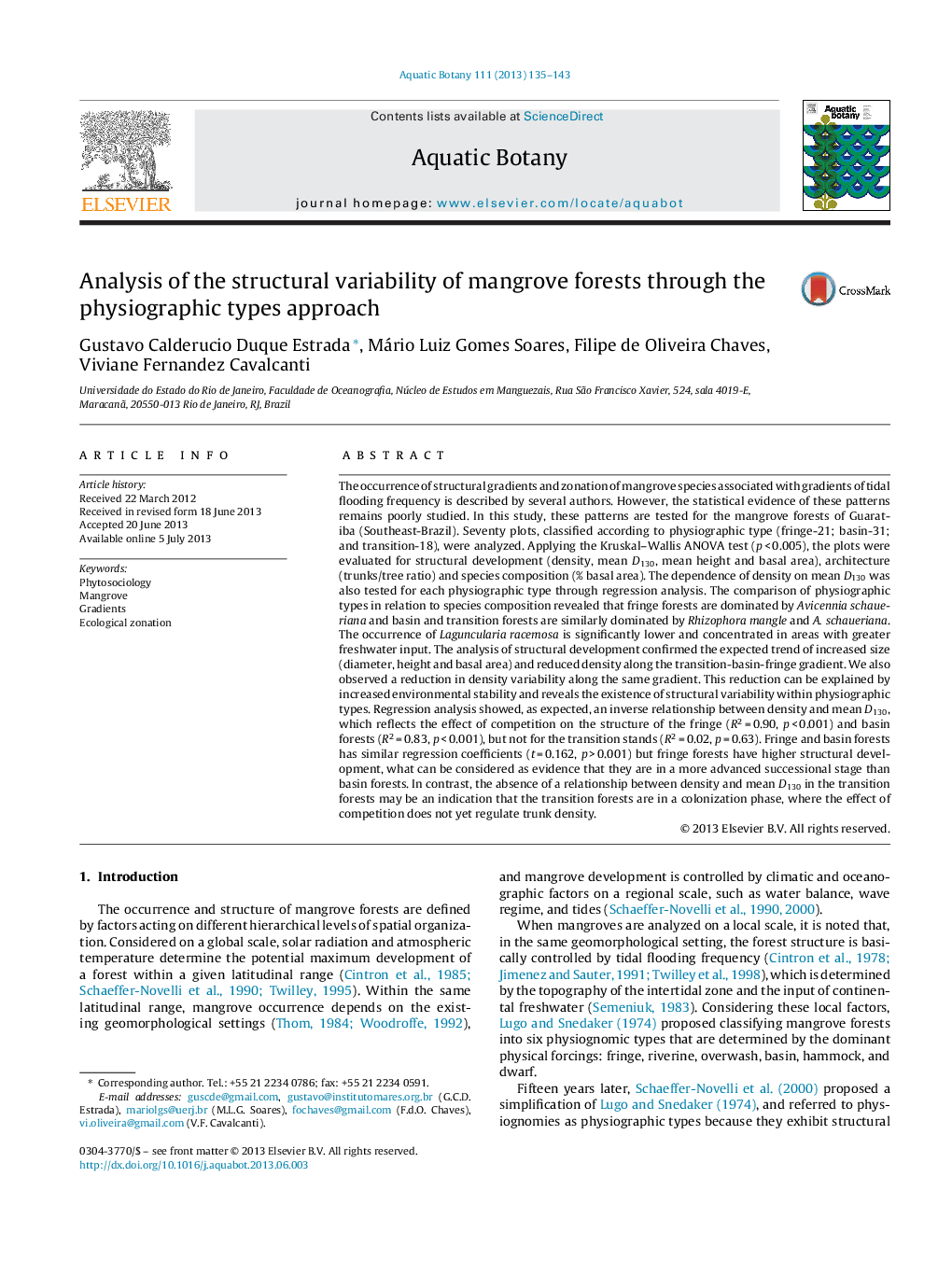| کد مقاله | کد نشریه | سال انتشار | مقاله انگلیسی | نسخه تمام متن |
|---|---|---|---|---|
| 4527858 | 1625831 | 2013 | 9 صفحه PDF | دانلود رایگان |
عنوان انگلیسی مقاله ISI
Analysis of the structural variability of mangrove forests through the physiographic types approach
دانلود مقاله + سفارش ترجمه
دانلود مقاله ISI انگلیسی
رایگان برای ایرانیان
کلمات کلیدی
موضوعات مرتبط
علوم زیستی و بیوفناوری
علوم کشاورزی و بیولوژیک
علوم آبزیان
پیش نمایش صفحه اول مقاله

چکیده انگلیسی
The occurrence of structural gradients and zonation of mangrove species associated with gradients of tidal flooding frequency is described by several authors. However, the statistical evidence of these patterns remains poorly studied. In this study, these patterns are tested for the mangrove forests of Guaratiba (Southeast-Brazil). Seventy plots, classified according to physiographic type (fringe-21; basin-31; and transition-18), were analyzed. Applying the Kruskal-Wallis ANOVA test (p < 0.005), the plots were evaluated for structural development (density, mean D130, mean height and basal area), architecture (trunks/tree ratio) and species composition (% basal area). The dependence of density on mean D130 was also tested for each physiographic type through regression analysis. The comparison of physiographic types in relation to species composition revealed that fringe forests are dominated by Avicennia schaueriana and basin and transition forests are similarly dominated by Rhizophora mangle and A. schaueriana. The occurrence of Laguncularia racemosa is significantly lower and concentrated in areas with greater freshwater input. The analysis of structural development confirmed the expected trend of increased size (diameter, height and basal area) and reduced density along the transition-basin-fringe gradient. We also observed a reduction in density variability along the same gradient. This reduction can be explained by increased environmental stability and reveals the existence of structural variability within physiographic types. Regression analysis showed, as expected, an inverse relationship between density and mean D130, which reflects the effect of competition on the structure of the fringe (R2 = 0.90, p < 0.001) and basin forests (R2 = 0.83, p < 0.001), but not for the transition stands (R2 = 0.02, p = 0.63). Fringe and basin forests has similar regression coefficients (t = 0.162, p > 0.001) but fringe forests have higher structural development, what can be considered as evidence that they are in a more advanced successional stage than basin forests. In contrast, the absence of a relationship between density and mean D130 in the transition forests may be an indication that the transition forests are in a colonization phase, where the effect of competition does not yet regulate trunk density.
ناشر
Database: Elsevier - ScienceDirect (ساینس دایرکت)
Journal: Aquatic Botany - Volume 111, November 2013, Pages 135-143
Journal: Aquatic Botany - Volume 111, November 2013, Pages 135-143
نویسندگان
Gustavo Calderucio Duque Estrada, Mário Luiz Gomes Soares, Filipe de Oliveira Chaves, Viviane Fernandez Cavalcanti,